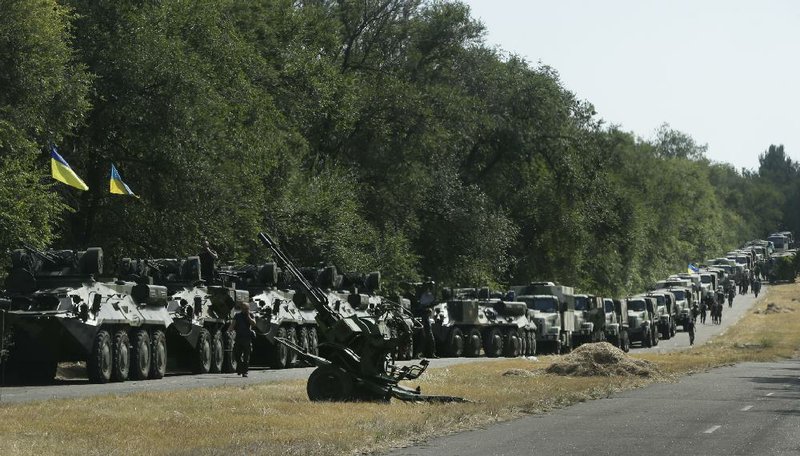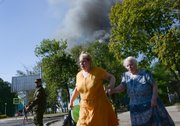NOVOAZOVSK, Ukraine -- Tanks, artillery and infantry have crossed from Russia into a previously unbreached part of eastern Ukraine in recent days, attacking Ukrainian forces and causing panic and wholesale retreat in a wide area, Ukrainian and Western military officials said.
The attacks outside Novoazovsk and in an area to the north essentially have opened a new, third front in the war in eastern Ukraine between government forces and pro-Russia separatists, along with the fighting outside the cities of Donetsk and Luhansk.
Exhausted, filthy and dismayed, Ukrainian soldiers staggering out of Novoazovsk for safer territory said Tuesday that they were cannon fodder for the forces from Russia. As they spoke, tank shells whistled in from the east and exploded nearby.
Some of the retreating Ukrainian soldiers appeared unwilling to fight. The commander of their unit, part of the 9th Brigade from Vinnytsia, in western Ukraine, barked at the men to turn around, to no effect.
"All right," the commander said. "Anybody who refuses to fight, sit apart from the others." Eleven men did, while the others returned to the city.
Some troops were in a full, chaotic retreat: A city-busload of them careened past on the highway headed west, purple curtains flapping through windows shot out by gunfire.
The mayor said rebel fighters with dozens of tanks and armored vehicles had entered Novoazovsk. A Ukrainian military spokesman said Wednesday that the army still controlled Novoazovsk but that 13 soldiers had died in the fighting.
Western and Ukrainian officials said Russia, despite its strenuous denials, is orchestrating a new counteroffensive to help the separatists of the Donetsk People's Republic, who have been reeling from aggressive Ukrainian military advances in recent weeks.
"Russia is clearly trying to put its finger on the scale to tip things back in favor of its proxies," a senior U.S. official said. "Artillery barrages and other Russian military actions have taken their toll on the Ukrainian military."
President Barack Obama's administration, which has placed increasingly punitive economic sanctions on Russia because of the Ukraine crisis, said over the past few days that the Russians had sent new columns of tanks and armor across the border.
"These incursions indicate a Russian-directed counteroffensive is likely underway," State Department spokesman Jen Psaki said Wednesday.
At the department's daily briefing in Washington, Psaki also criticized what she called the Russian government's "unwillingness to tell the truth" that its military had sent soldiers inside Ukraine's territory.
Psaki apparently was referring to videos of captured Russian soldiers, distributed by Ukraine's government Tuesday, that directly challenged President Vladimir Putin's assertions that Russia is a bystander in the conflict. The videos were publicized just as Putin was meeting with Ukrainian President Petro Poroshenko in Belarus.
Russian forces, she said, are being sent 30 miles inside Ukraine, without them or their families knowing where they are going. She cited reports of burials in Russia for those who've died in Ukraine.
Russian forces have been trying to help the separatists break the siege of Luhansk and have been fighting to open a corridor to Donetsk from the Ukrainian-Russian border, Western officials said.
To the south, Russia has been backing a separatist push toward the southern town of Mariupol, a major port on the Sea of Azov, according to Western and Ukrainian officials. The Russian aim, one Western official said, is to open a new front that would divert Ukrainian forces from Donetsk and Luhansk and to possibly seize an outlet to the sea in the event that Russia tries to establish a separatist enclave in eastern Ukraine.
Some Western officials fear the move might be a step in a broader Russian strategy to carve out a land link to Crimea, the Ukrainian peninsula that Russia annexed in March. Ukraine has already lost more than 450 miles of coastline in Crimea, along with a major naval port and significant mineral rights in the Black Sea.
If the separatists were to seize a land bridge to Crimea, that would be a further loss of more than 150 miles of coastline. That would also give them or Russia control over the entire Sea of Azov and any offshore oil and gas reserves.
The Russian military's use of artillery from locations within Ukraine is of special concern to Western military officials, who say Russian artillery has already been used to shell Ukrainian forces near Luhansk. Along with the anti-aircraft systems operated by separatists or Russian forces inside Ukraine, the artillery has the potential to alter the balance of power in the struggle for control of eastern Ukraine.
Russia has denied that it has intervened militarily in Ukraine, and the separatists have said they are using captured Ukrainian equipment. But U.S. officials say they are confident that the artillery in Ukraine's Krasnodon area is Russia's, since Ukrainian forces have not penetrated that deeply into that separatist-controlled region. U.S. officials also said the separatists have no experience in using such weaponry.
"We judge that self-propelled artillery is operated by Russians rather than separatists since no separatist training on this artillery has occurred to date," an Obama administration official said, speaking on condition of anonymity.
The United States has photographs that show the Russian artillery moved into Ukraine, U.S. officials said. One photo dated Aug. 21, shown to a reporter from The New York Times, appears to show Russian military units moving self-propelled artillery into Ukraine. Another photo, dated Saturday, shows the artillery in firing positions in Ukraine.
Advanced air defenses, including systems not known to be in the Ukrainian arsenal, also have been used to blunt the Ukrainian military's air power, U.S. officials said. In addition, they said, the Russian military routinely flies drones over Ukraine and shares the intelligence with the separatists.
German Chancellor Angela Merkel spoke with Putin on Wednesday about the situation in Ukraine, both governments said. Merkel stressed Russia's responsibility for a de-escalation of the conflict and for surveillance of its border, her spokesman, Steffen Seibert, said in a statement.
The Ukrainian retreat from the border area near Novoazovsk, which began Tuesday, came as Putin told Poroshenko that the Ukrainian insurgency was an internal matter and that the Ukrainian government needed to negotiate a cease-fire.
On the highway in Novoazovsk, Sgt. Ihor Sharapov, a soldier with the Ukrainian border patrol unit, said he had seen tanks drive across the border from Russia but marked with flags of the Donetsk People's Republic.
"I tell you they are Russians, but this is what proof I have," said Sgt. Aleksei Panko, holding up his thumb and index finger to form a zero. Panko estimated that about 60 armored vehicles crossed near Novoazovsk. "This is what happened: They crossed the border, took up positions and started shooting."
The Ukrainian Vinnytsia brigade met the cross-border advance over the 6 miles of countryside separating Novoazovsk from the Russian border, but later retreated to the western edge of town along the Rostov-Mariupol highway, where soldiers were collapsed in exhaustion on the roadside.
"This is now a war with Russia," Panko said.
Information for this article was contributed by Andrew E. Kramer, Michael R. Gordon and Eric Schmitt of The New York Times and by Peter Leonard, Jim Heintz, Nicolae Dumitrache, Monika Scislowska, Kirsten Grieshaber, Lynn Berry and Laura Mills of The Associated Press.
A Section on 08/28/2014


